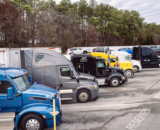The Biden Administration on March 12 released its National Zero-Emission Freight Corridor Strategy, a plan for the deployment of heavy-duty electric vehicle charging and hydrogen fueling infrastructure along freight corridors. The Administration is expected as soon as next week to release EPA’s final heavy-duty vehicle emission standards.
The National Zero-Emission Freight Corridor Strategy was developed by the Joint Office of Energy and Transportation and the Department of Energy (DOE), in collaboration with the Department of Transportation (DOT), and the Environmental Protection Agency (EPA) to prioritize investments for the development of zero-emission infrastructure along the nation’s freight corridors that enable deployment of battery electric and hydrogen fuel cell trucks.
The strategy outlines a four-phase adoption of ZE-MHDVs, initially focused on key freight hubs with a 100-mile radius in Phase 1, moving toward building out a complete zero-emission freight network in Phase 4.
NATSO and its industry allies issued a statement to media commending the Biden Administration for recognizing the critical link between how freight moves and the efficient build out of a nationwide network of charging stations for medium and heavy-duty trucks. Directing states to adopt a phased approach that prioritizes investments along key freight corridors can harness the existing nationwide network of refueling locations along the Interstate Highway System and encourage investment in emerging refueling technology.
[NATSO statement on National Zero-Emission Freight Corridor Strategy]
EPA is expected in coming days to issue its final heavy-duty greenhouse gas emissions rule. In its proposed rule, EPA proposed more stringent standards to reduce greenhouse gas emissions from heavy-duty vehicles. The aggressive timeline called for 35 percent of medium-heavy duty trucks and 40 percent of heavy-heavy duty truck sales to be electric in 2032.
NATSO and its allies previously filed comments urging EPA to reconsider its Proposed Rule and instead put forth standards that would let the market, guided by consumers, meet the agency’s climate goals. NATSO urged a technology neutral approach to reducing carbon emissions and urged EPA not to depend on one technology to “act as a silver bullet.”
NATSO also continues to urge EPA not to overlook the existing fuels reducing carbon emissions from the existing fleet of trucks that will be in operation for many years to come.
[NATSO Urges EPA to Adopt Technology-Neutral Approach to GHG Standards for Heavy Trucks]
Renewable diesel and biodiesel represent the best opportunity for reducing carbon emissions from the commercial trucking sector for the foreseeable future. Establishing sensible tailpipe emissions in conjunction with strong incentives for renewable liquid fuels will encourage investments in currently scalable technologies that can reduce the carbon footprint of fuels that are in use today.
Subscribe to Updates
NATSO provides a breadth of information created to strengthen travel plazas’ ability to meet the needs of the travelling public in an age of disruption. This includes knowledge filled blog posts, articles and publications. If you would like to receive a digest of blog post and articles directly in your inbox, please provide your name, email and the frequency of the updates you want to receive the email digest.

